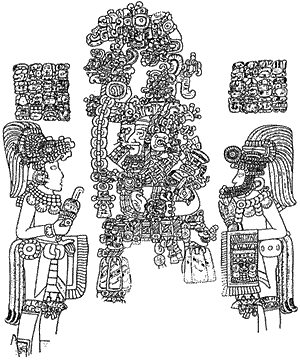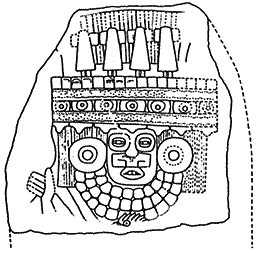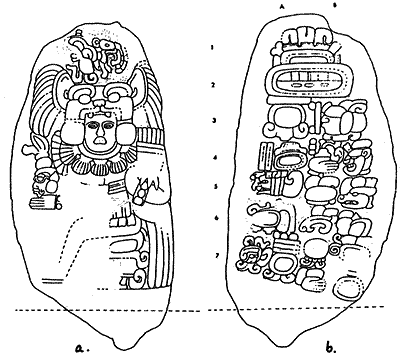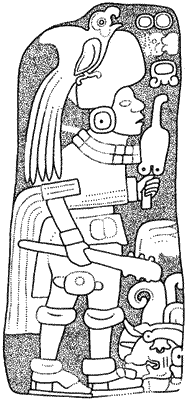
David Stuart
Peabody Museum
Harvard University
Extract of a paper presented at Princeton University
October 1996 - Revised February 1998
|
This paper revisits a much-debated topic in Mesoamerican archaeology: the nature and scope of the political interaction between the highlands of central Mexico and the Maya lowlands during the Classic period (ca. 250-850 A.D.).
Scholarship is polarized around two different propositions. The first posits an overt and disruptive Teotihuacan presence in the Maya lowlands in the late fourth century A.D., associated with military incursions if not political domination. The second suggests that Teotihuacan styles and material remains in the Maya area might better be seen as a local appropriation of prestigious or legitimating symbolism and its associated militaristic ideology. To complicate matters even more, the political and economic ties that existed between Teotihuacan and Maya polities presumably changed over the centuries as fortunes and societies on both ends shifted in their own localized way. We know that Mesoamerican political interactions, alliances and hierarchies could shift and realign themselves with surprising speed, sometimes within a generation or two. Rather than insist on a dichotomous either-or-model, it is possible that both the "externalist" models and "internalist" models outlined above have merit and explanatory power when applied at different times in Classic history. Where, then, does this leave our debate? In my view, traditional lines of archaeological evidence are limited in their capacity to provide an explanatory context for the sort of intensive culture contact so evident at Tikal and Copan. Advancing the discussion and debate requires a more detailed historical context that can only be provided from an analysis of the preserved hieroglyphic texts at Tikal, Copan and other Maya centers. The potential importance of the hieroglyphic texts is clear, but it is surprising how seldom they have been used to clarify the history underlying Teotihuacan-Maya interactions. With the exception of Proskouriakoff, most epigraphic work on central Peten history has assumed a more "internalist" perspective, often ignoring the Teotihuacan issue altogether. I argue in this essay that the hieroglyphic texts at Tikal, Copan and other Maya sites offer insights into Maya perceptions of a dynamic and often changing relationship with central Mexico. As we shall see, such sources strongly support a more "externalist" view that Teotihuacan played a very direct and even disruptive role in the political history of Maya kingdoms. In addition to the historical details surrounding this highland-lowland encounter, Classic Maya inscriptions and iconography allow us to perceive how the Maya consciousness of Teotihuacan changed and developed over the course of four centuries, melding the formidable power and memory of that foreign city with their own political symbolism and ideology. It is therefore in the latter part of the Classic period, after the collapse of Teotihuacan, that the less direct "internalist" model comes into play. I will argue that Maya rulers kept open a claim to this earlier history, evoking Teotihuacan as both a place and an idea of political origin. This discussion will be based in large part on my earlier decipherment of the Classic Maya name for Teotihuacan, "Place of Cattails," (equivalent to Nahuatl Tollan) and the implications that this has presented for Mesoamerican studies. I will confirm and elaborate on the antiquity of what might be called the "Tollan paradigm" of Mesoamerican political power and self-representation. Although this concept would later pervade Mesoamerica through many so-called "Tollans", I will suggest that Teotihuacan was the archetype, having played a direct and active role in founding political orders within the Maya area.
A Teotihuacan presence in the Maya lowlands was evident from an early date. Most striking of all evidences was the discovery of sculptured monuments bearing portraits of "Mexican" individuals, such as Stela 31 at Tikal with its image of a warrior in Teotihuacan dress grasping a rectangular shield and atlatl spearthrower.

Stela 31 at Tikal zoom Stela 32, also found in the Tikal North Acropolis, shows a highland warrior wearing a so-called "tassel headdress" and is in even more direct Teotihuacan style. 
Stela 32 at Tikal Proskouriakoff's treatment of early Tikal history remains one of the most compelling, despite being originally conceived nearly thirty years ago. In that work she notes that the early Tikal King "Great Paw" (or "Jaguar Paw," as in current literature) was among the earliest documented rulers of the Early Classic, associated with the Long Count date 8.14.0.0.0 (317 A.D.), as recorded on the back of Stela 31, the single most important text for studying early Tikal history. The next date recorded on Stela 31 is written simply as "11 Eb," equivalent to 8.17.1.4.12 11 Eb 15 Mac, or Jan. 16, 378 A.D. This date is one of the most significant -- and debated -- in early Maya history. Less than a year later, a new king assumes power, named Nun Yax Ayin (customarily known by the nicknames "Curl Nose" or "Curlsnout").
The diminutive Teotihuacan "warrior" shown twice on the sides of Stela 31 is named in the accompanying captions as Nun Yax Ayin himself. Stela 4 bears another portrait of him, again in Teotihuacan costume, and commemorates the k'atun ending 8.18.0.0.0 (396 A.D.). On the basis of such strong archaeological and visual evidence, Nun Yax Ayin has been called a foreign king.

Stela 4 at Tikal That much seems clear, but the circumstances surrounding his sudden appearance at Tikal have heretofore been cloudy at best. A better understanding of just what happened requires a revisit to the 11 Eb event which occurred a year before his accession, commemorated in several inscriptions at Tikal and Uaxactun.
In her important overview of Maya history, Proskouriakoff devoted one chapter to what she called "the arrival of strangers" in the Maya lowlands in the late fourth century A.D. The "strangers" were from the highlands and included the Tikal ruler Nun Yax Ayin. As Proskouriakoff noted, other names seemed to be recorded in the inscriptions of this time as well, and it is their respective roles in this history that are very illuminating.
Proskouriakoff recognized that the 11 Eb date falling shortly before the accession of Nun Yax Ayin was a pivotal event of some sort. It was recorded on Stela 31 of Tikal as well as on Stela 5 and 22 of Uaxactun (one of the few historical dates repeated at different sites).

Stela 5 at Uaxactun It was immediately apparent to her that a foreigner with Central Mexican associations appeared in direct association with the 11 Eb date, and was somehow connected with the arrival of foreigners into the central Peten, perhaps specifically at Uaxactun. According to Tikal's Stela 31, Nun Yax Ayin was the son of an individual whose name glyph is written with two signs, one a hand grasping an atlatl, the other a "cauac" element with "tufts" at its four corners. "Atlatl Cauac" or "Spearthrower Owl" was not the king who preceded Nun Yax Ayin, whom we know to have been Jaguar Paw. Clearly we are faced with an unusual break in the customary father-to-son pattern of succession to office. The 11 Eb event, with all its indirect connections to Teotihuacan influence, stands directly at the time of this disruption, within a year before the accession of the "foreign king". The four extant records of the 11 Eb episode at Uaxactun and Tikal are all very different in presentation, and each text might contribute different pieces to the overall historical puzzle. One "constant" in this is the personal name of yet another figure called "Smoke Frog," "Smoking Frog," or, as I suggest, Siyah K'ak', "Fire is Born;" who, as protagonist of the 11 Eb event in all four inscriptions, is a pivotal figure in understanding Maya-Teotihuacan relations in the fourth century. In reviewing the readable glyphs associated with 11 Eb and Siyah K'ak', I have concluded that the posited Tikal-Uaxactun war never actually happened, at least in connection with the date in question. The four relevant texts at Tikal and Uaxactun contain no known "war" glyph. Moreover, there is no firm evidence that Siyah K'ak' was from Tikal; his name glyph on Uaxactun Stela 5 is followed by the Tikal emblem sign, but without any accompanying title such as "ahaw." On Stela 5 and 22 at Uaxactun, the event glyphs found with the 11 Eb date are clearly hul-iy, "he, she, it arrived," (the event glyph deciphered by Barbara MacLeod). Importantly, other similar "arrival" events documented in the royal histories revolve around the appearance of "outsiders" who bring with them significant political change. On the Tikal "Marcador" stone, the opening Long Count date is our familiar "arrival" date of 8.17.1.4.12 11 Eb 15 Mac, with Siyah K'ak' clearly named as the protagonist. Of all the records of this event, that which is on Tikal Stela 31 is the most important and informative. The 11 Eb date is clearly written after the record of the 8.17.0.0.0 k'atun ending overseen by "Jaguar Paw." The protagonist on Stela 31 is Siyah K'ak', and a second sentence that follows names Jaguar Paw as its subject. The inscription seems to be saying that on the very day Siyah K'ak' arrived, the king of Tikal died. It would be hard not to view Jaguar Paw's death as the result of an episode of aggression, and a signal of great political change.
Judging by the importance accorded to the event, the arrival of Siyah K'ak' on January 16, 378 A.D. was highly significant. But the texts say almost nothing about the circumstances surrounding it. The only indication of the event's character is provided by Stela 31's mention of Jaguar Paw's death on the very same day. I would interpret this as evidence that the arrival was more than a simple visitation of outsiders. It may well have been accompanied by violence and the execution of the reigning Tikal lord, but it should be cautioned that the language of these texts is seldom so explicit. Siyah K'ak' is named on other inscriptions at Tikal, including Stela 4, which bears the accession date of Nun Yax Ayin, who is named as the protagonist of the monument and is presumably the figure portrayed on the front. Following the record of the ruler's accession in 379 A.D., we find the glyph y-ahaw, "...the lord of...," and then name of Siyah K'ak'. The relationship expressed between the two names is highly significant. First identified by Houston and Mathews, the "lord of" glyph apparently expresses a hierarchichal relationship of some sort between two rulers, where the second-named person (Siyah K'ak' in this case) is in some way superior to the first (Nun Yax Ayin). We are forced to conclude from Stela 4 that Siyah K'ak' in some way dominated or sponsored Nun Yax Ayin at the time of the latter's accession. The same relationship seems to be implied by the portion of Stela 31's text which records Nun Yax Ayin's inauguration. There is no choice but to conclude that Siyah K'ak' is a foreigner and may well be the instigator of the Teotihuacan presence in the region of Tikal. If allowed to speculate, I would go so far as to view him as the leader of a military force that overthrew Tikal's dynasty in 378, killing its ruler Jaguar Paw and installing a new ruler, Nun Yax Ayin, in his place.
Another mysterious participant in early Tikal history was "Spearthrower Owl" (also known as "Atlatl Shield" or "Atlatl Cauac"). Spearthrower Owl is named as the father of the newly installed Tikal ruler Nun Yax Ayin, and is thus the grandfather of the later ruler Siyah Chan K'awil. Significantly, there is no evidence that Spearthrower Owl was ever a ruler of Tikal. The foreign associations with this personage are very suggestive. The components of his name glyph are a case in point. The spearthrower or atlatl is a distinctively highland weapon, and the owl is strongly associated with militaristic themes in Teotihuacan iconography. The visual and historical link of this name to highland Mexico is inescapable, and I think generally agreed upon. In proposing that the Spearthrower Owl glyph at Tikal serves as a personal name, I go against previous interpretations by Proskouriakoff and Schele and Freidel, who all viewed it as a general label or title, shared by more than one person. Schele and Freidel agreed with a Teotihuacan connection for the Spearthrower Owl glyph, and linked it to the larger highland-derived "Tlaloc-Venus" iconographic complex revolving around themes of conquest warfare and sacrifice. Several key points cast doubt on the function of the Spearthrower Owl glyph as a title or general label, and suggest instead that it was a personal name of a politically important individual. On Stela 31 of Tikal, the Spearthrower Owl glyph (its "Atlatl Cauac" variant) occupies the position where Nun Yax Ayin's father must be named. Elsewhere on Stela 31, Spearthrower Owl bears the now-familiar title Kalomte', found with personal names throughout the entire body of Maya inscriptions. Moreover, Stela 31 mentions near the end of its text a death even (och bi), followed by the Spearthrower Owl glyph. Only a true personal name could serve in such a context. What is more, on the front of Stela 31 the Tikal ruler Siyah Chan K'awil holds aloft a headdress adorned with a Spearthrower Owl "medalion" at its top. The glyph is shown within a cartouche that is part of a maize-plant motif. In Early Classic Maya portraiture, such maize plants in the headdress contain personal names, precisely as shown in the Stela 31 example. Here the headdress is labeled with the name of its intended wearer, Spearthrower Owl, revealing that, contrary to other interpretations, it is about to be worn by Siyah Chan K'awil. Just why Spearthrower Owl's headdress is shown with no sign of Spearthrower Owl himself is something of a mystery; as with Siyah K'ak', no known portraits of him exist. Spearthrower Owl is associated with only a few events in Tikal's historical records. We first encounter him on the Marcador of Tikal, where he is named three times. According to the text, Spearthrower Owl sees or in some way sanctions the arrival of Siyah K'ak' in 378 A.D. Although he is somehow involved in the arrival episode, the first date associated with him actually falls a few years earlier and also is recorded on the Marcador. This is 8.16.17.9.0 11 Ahau 3 Uayeb (374 A.D.), which is clearly given as an accession date. Spearthrower Owl is therefore seated in office as ruler, but where? To reiterate, Jaguar Paw was most certainly ruler of Tikal at this time, leading up to the arrival of Siyah K'ak'. In fact, Spearthrower Owl lives on for a considerable amount of time. He is named in association with the dedication of the Marcador monument at Tikal on 8.18.17.14.9, a date wihin the reign of his son at Tikal. Finally, his death was recorded on Stela 31 as occurring on 9.0.3.9.18, well within the reign of his grandson, Siyah Chan K'awil ("Stormy Sky"). In sum, Spearthrower Owl, father of a Tikal ruler, was himself a king, and reigned somewhere for over six decades (374-439 A.D.). Although difficult to prove, one very real possibility to consider is that Spearthrower Owl was a ruler of Teotihuacan. Unlike the other characters in this plot such as Siyah K'ak' and Nun Yax Ayin, Spearthrower Owl's name is probably not Mayan. Visually, at least, it evokes a "foreigness" unlike any other personal name in Maya history. But most suggestive of all is the established fact that Spearthrower Owl is father to Nun Yax Ayin, the one king at Tikal who is singled out for his highland style of costume. Is it farfetched to believe that the father of Nun Yax Ayin, the one supposed "foreigner," was himself of the highlands? I think not. Considering that Spearthrower Owl was a high ruler, the idea of his being a Teotihuacan king has a certain appeal.
A common title of Spearthrower Owl is Kalomte', also used by Siyah K'ak' on occasion. In later Maya history, this title conveys a supreme status within a political hierarchy. It is the office for high kings of Late Classic Tikal and possibly Calakmul, and Simon Martin has suggested that it serves to mark overlords or "emperors" of conquered territories. Lacking a decipherment of the term kalomte', it is difficult to be precise about the literal meaning of the glyph, yet the pattern of its use is clear enough in the later sources. It would suggest that both Spearthrower Owl and Siyah K'ak' held considerable political power, perhaps involving the control of distant locales. This interpretation is in keeping with my proposal that Spearthrower Owl is the name of the Teotihuacan ruler. Siyah K'ak', in turn, having arrived at Tikal, may have been the local representative of Mexican control in the central Peten, a role that would agree with his being named as an overlord in historical texts in the central Peten region, such as Bejucal. Spearthrower Owl's birth date is not known. A few years after the accession of Spearthrower Owl to office in 374 A.D., the closely affiliated character Siyah K'ak' arrives at Tikal and assumes a powerful role there, possibly as some sort of regional political leader (Kalomte'). Siyah K'ak', as we have seen, had an important "overseeing" role in the inauguration of Spearthrower Owl's son at Tikal. Now, if we are to believe that Spearthrower Owl acceded to his throne in 374 and died in 439 (sixty-five years later), then logic would dictate that the son, Nun Yax Ayin, must have been very young at the time of his own inauguration at Tikal in 379. There is support for this, including both written and artistic evidence. On the right side of Stela 31, the caption accompanying Nun Yax Ayin's portrait states that he was a "'k'atun' lord", or that he was less than twenty years old as depicted. Siyah K'ak's own role as an "overseer" of Nun Yax Ayin's accession and ruler over the satellite centers suggests that Siyah K'ak' served as a sort of regent for the child-king from Teotihuacan. Spearthrower Owl may have sent his son to rule once Siyah K'ak' laid the groundwork at Tikal and consolidated much of the power within his own hands.
The history I have discussed up to this point is certainly a detailed one, combining both firm facts and speculative assertions. In order to clarify my overall interpretation and present the more solidly grounded facts as I understand them, a few points of summary are here offered, with events arranged in chronological order (specific sources are given in italics):
2. Another figure named Siyah K'ak' arrives at Tikal and/or Uaxactun on January 14, 378 A.D., apparently with the direct or indirect sanction of Spearthrower Owl (Tikal, Marcador, Stela 31; Uaxactun, Stelae 5, 22). 3. On the very same day of the "arrival," the Tikal ruler Jaguar Paw dies, or "enters water" (Tikal, Stela 31). 4. Siyah K'ak's arrival is from the west, having days earlier arrived (?) at El Peru (El Peru, Stela 15). This may relate to the common use of the "west" glyph in his glyphic name phrase. 5. Within a year after Siyah K'ak's arrival, Nun Yax Ayin ("Curlnose") assumes the rulership of Tikal, introducing overt Teotihuacan imagery into the monumental art (Tikal, Stelae 4, 31). His father is Spearthrower Owl, and not the previous Tikal king Jaguar Paw (Stela 31, side texts). 6. Nun Yax Ayin may have been a boy at the time of his inauguration (Stela 31). Siyah K'ak' in some way oversees his inauguration (Stela 31), and may have also been dominant over the local ruler of Bejucal, a small site on Tikal's periphery (Bejucal, Stela 1).
7. Spearthrower Owl has very strong Teotihuacan associations, and his name is depicted as a so-called "heraldic emblem" in much Teotihuacan iconography. Evidence suggests that he was perhaps ruler of that site. He dies in 439 A.D. (Tikal, Stela 31), during the reign at Tikal of his grandson, Siyah Chan K'awil ("Stormy Sky").
That said, much of what is presented here stands in contrast to previous studies of Tikal's history. Most important perhaps is the revision of the nature of the 11 Eb event as "arrival," much as Proskouriakoff originally reasoned. If this is true, it is difficult to reconcile with the supposed Tikal-Uaxactun war posited by Mathews and Schele and Freidel. Rather, I view this as the single most important political or military episode of early Classic Maya history, when Teotihuacan established itself as a dominant force in the politics and elite culture of the central Peten. There is now ample evidence, I believe, to support the interpretation that the arrival was a highly disruptive occasion, if not a violent one. The direct instrument of this change was Siyah K'ak', who seems to have wielded considerable influence and power at Tikal and Uaxactun in the years subsequent to his arrival. His placement at Tikal allowed for the installation of Nun Yax Ayin, the son of the possible Teotihuacan ruler Spearthrower Owl. This new dynasty of Tikal, as far as we know, continues unbroken for many years, through the reigns of Siyah Chan K'awil and Kan Boar, after which we come to the opaque history surrounding the so-called "hiatus" and the Early-to-Late Classic transition. Later still, in the midst of Tikal's Late Classic rivalry against Calakmul and its allies, the early history rooted in Teotihuacan would continue to be recalled and commemorated. Ruler C, first identified by Jones, was named Nun Yax Ayin, in remembrance of the intrusive king of centuries past. Most interesting also are the surviving wooden door lintels of Temple 1, dedicated by the king Hasaw Chan K'awil (Ruler A). Lintel 3 records the thirteen k'atun anniversary (in 695 A.D.) of Spearthrower Owl's death, stating that on this day Hasaw Chan K'awil "conjured the Holy One." The adjacent door lintel of this temple, Lintel 2, depicts a seated Teotihuacan warrior above a toponymic register of cacti and cattails, and beneath a large Teotihuacan War Serpent. Given the anniversary celebrated in the temple, it is tempting to see this as a portrait of Spearthrower Owl himself, but such an interpretation should be tempered by the fact that the name of Hasaw Chan K'awil accompanies the image. I would nevertheless see the themes of the two lintels as closely connected, revolving around the anniversary of the demise of a venerated ancestor who was also a foreign king. |